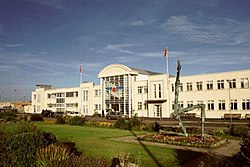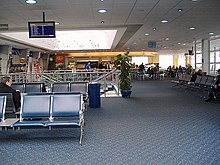Isle of Man Airport
| Isle of Man Airport Purt Aer Vannin |
|
|---|---|

|
|
| Characteristics | |
| ICAO code | EGNS |
| IATA code | IOM |
| Coordinates | |
| Height above MSL | 16 m (52 ft ) |
| Transport links | |
| Distance from the city center | 11 km southwest of Douglas |
| Street | A5 motorway |
| train | Ronaldsway Railway Station |
| Local transport | Bus 1, 1C, 2, 2A and 8 |
| Basic data | |
| opening | 1928 |
| operator | Department of Infrastructure |
| Passengers | 729,703 (2014) |
| Air freight | 2,879 t (2014) |
| Flight movements |
27,645 (2014) |
| Runways | |
| 08/26 | 1754 m of asphalt, concrete |
| 03/21 | 1199 m of asphalt |
The Isle of Man Airport ( english Isle of Man Airport , Manx Pur Aer Vannin ) is the only commercial airport in the Isle of Man . It is located southwest of the capital Douglas near Ronaldsway and, along with the port, is the most important gateway to the island in the Irish Sea .
history
Before World War II
Ronaldsway was first used as a take-off and landing site in 1928. Passenger flights to the United Kingdom, operated by Blackpool and West Coast Air Services, started in 1933. A year later, in 1934, Aer Lingus and Railway Air Services expanded the service. In 1937 Isle of Man Air Services took over Railway Air Services. In 1936, during the expansion of the airport, a mass grave was discovered in which the soldiers of the Battle of Ronaldsway are believed to be buried.
Second World War
RAF Ronaldsway
At the beginning of World War II , the Royal Air Force took control of the airport. The airport, now called RAF Ronaldsway, was one of the few that continued civilian passenger flights during the war. In 1943 the airfield was handed over to the Admiralty and expanded into a training station for the Fleet Air Arm .
HMS Urley
Now called RNAS (Royal Naval Air Station) Ronaldsway as the base of the Fleet Air Arm , the airport was closed for almost twelve months in 1943 and extensively expanded. In the summer of 1944, the expansion from the grass landing area with a few hangars to a 4-runway airport was completed. With the expansion, three training squadrons of the Royal Navy, which were equipped with Fairey Barracuda torpedo bombers, among other things , were stationed there. In 1944 the airport was renamed HMS Urley (Urley = eagle in manx) and operated until 1945.
post war period
Shortly after the end of the war, the airport was only used for civil flights, but the area remained in the possession of the Admiralty. In 1948 it was 200,000 pounds sold It is the government of the Isle of Man, a small price compared to the cost of one million pounds for the expansion and 105,000 pounds for the purchase of the site by the Admiralty. In the first post-war years, various domestic airlines operated flights to the mainland. Nowadays, the Manx Military and Aviation Museum next to the airport provides information on the history of aviation on the island.
Younger development
An extensive expansion of the airport began in 1998. In March 2000 the extension was opened, in which the arrival area, the baggage hall, the departure lounge and the restaurant area are located. The old part of the airport has been renovated and now offers improved check-in facilities and offices. In 2008, work began on extending and renewing the runway. An artificial headland was created for this purpose. A new control tower was also built.
statistics
In 2009, 708,127 passengers arrived and departed, which is a loss of 6.1% compared to 2008. At the end of the 1990s, around 4,000 tons of cargo were transported annually, but after the collapse of Emerald Airways in 2009, only around 500 tons were transported.
Airlines and Destinations
| Airline | Destination |
|---|---|
| Aer Lingus Regional | Dublin |
|
British Airways operated by Loganair |
London City |
| Eastern Airways | Durham (starts May 30, 2020) |
| easyJet |
Belfast – International , Bristol , Liverpool , London – Gatwick Seasonal: London – Luton |
| Loganair | Edinburgh , Liverpool |
Incidents
- On June 30, 1962, the landing gear of a Bristol 170 Mk.21 of Silver City Airways ( aircraft registration G-AGVC ) collapsed on landing at Ronaldsway Airport. The machine was irreparably damaged, the occupants were uninjured. (Note: In the Aviation Safety Network source, the operator is incorrectly referred to as "Manx Airlines".)
Web links
- Website of the Isle of Man Airport (english)
Individual evidence
- ↑ a b c UK Airport Statistics: 2014 - annual
- ↑ IOM-Airport, History section, English language: Archive link ( Memento of the original from June 15, 2013 in the Internet Archive ) Info: The archive link was inserted automatically and has not yet been checked. Please check the original and archive link according to the instructions and then remove this notice.
- ^ Loganair to take on Flybe route from Isle of Man to Liverpool. In: itv.com. March 10, 2020, accessed on March 11, 2020 .
- ↑ Maurice J. Wickstead: Airlines of the British Isles since 1919 . Air-Britain (Historians) Ltd., Staplefield, W Sussex 2014, ISBN 978-0-85130-456-4 , p. 377.
- ^ Accident report Bristol 170 G-AGVC , Aviation Safety Network (English), accessed on August 5, 2019.

